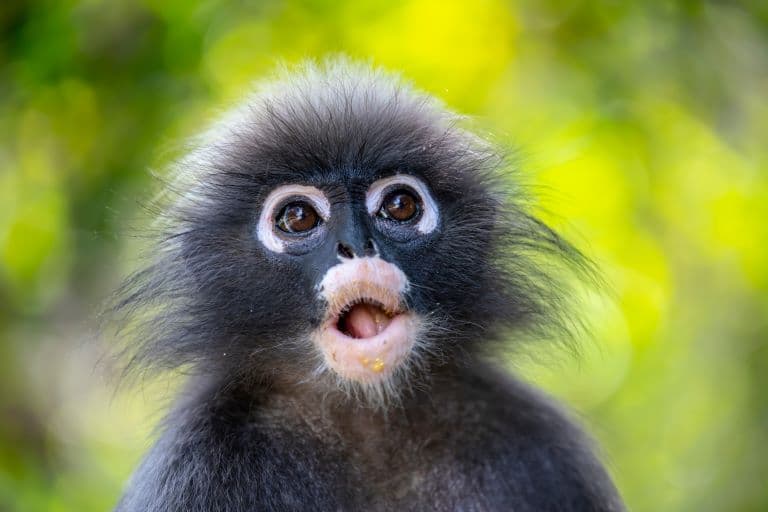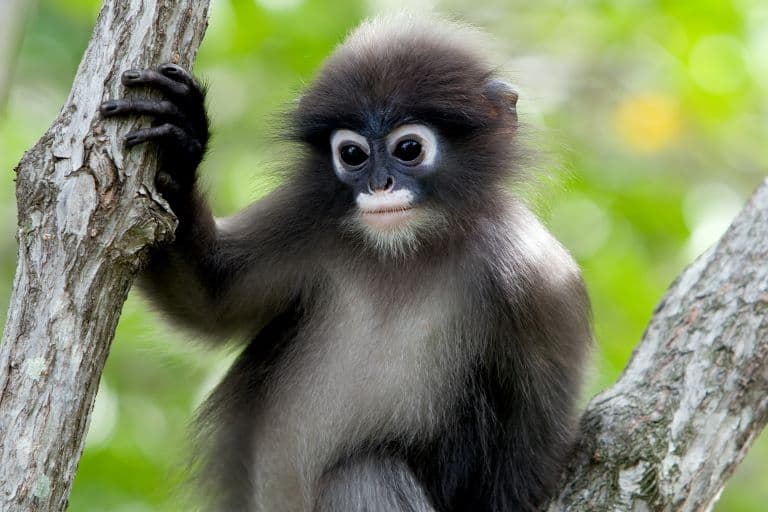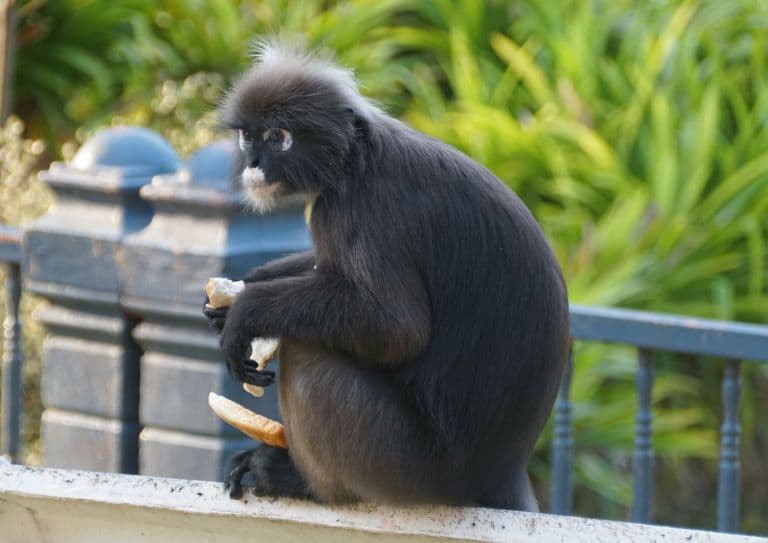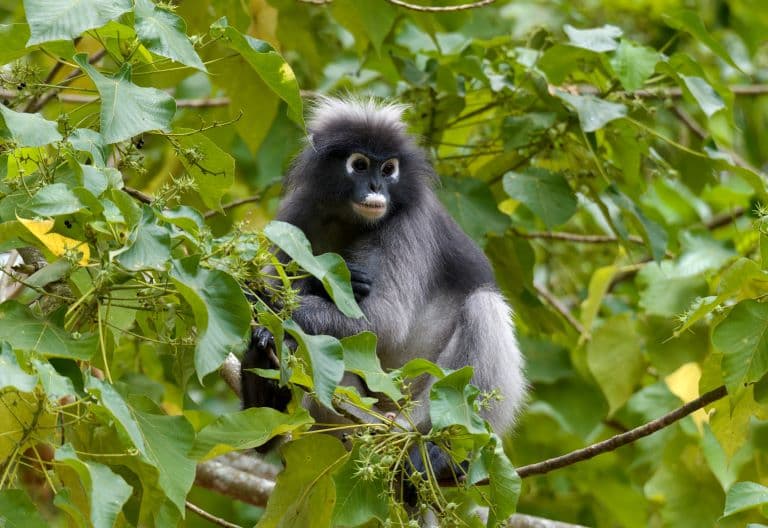Dusky Leaf Monkey Profile
The eyes are more important than you might think in primate communication. Humans have bright white eyeballs that allow the following of the gaze, which helps people understand each other’s intentions.
Baboons, for whom prolonged eye contact can be a challenge, have evolved bright eyelids that clearly show when they’re not staring at you.
Then we have the dusky leaf monkey, or as it’s sometimes known, the spectacled langur, who has taken eye markings to the extreme.

Dusky Leaf Monkey Facts Overview
| Habitat: | Closed, primary or old-growth secondary forest; plantations, parks |
| Location: | Malaysia, Myanmar, and Thailand |
| Lifespan: | Up to 31 years in captivity, average around 15 in the wild |
| Size: | 60 cm (2 ft) long, with an 85 cm (33 in) tail |
| Weight: | Up to 7 kg (15 lb) |
| Colour: | Mostly black, grey front; white eyes and mouth |
| Diet: | Mostly leaves |
| Predators: | Humans, |
| Top Speed: | Not listed |
| No. of Species: | 1 |
| Conservation Status: | Endangered (IUCN) |
The Dusky leaf monkey is also known as the dusky (or spectacled) langur and shares a genus with the other langurs of Asia.
This species isn’t too exclusive about the animals it shares its habitat with and is often found among other species of primate and other arboreal mammals.
This communal attitude brings with it a high degree of sociality, and there are many behaviours among these small monkeys that are very familiar from our own lives.
One noticeable difference is the bright orange babies, but otherwise, these adaptable, intelligent monkeys are a reminder that we are not long out of the trees ourselves.
Interesting Dusky Leaf Monkey Facts
1. They’re langurs
The Trachypithecus genus, which translates roughly to “rough monkey”, contains quite a bunch of simians – at least 21 species – including the lutungs and langurs, which represent different ‘groups’ within the genus but are essentially just different species of the same thing.
Leaf monkeys are a third group, but can be called langurs too if you like.
The Dusky leaf monkeys are also commonly known as spectacled langurs, in reference to their bright white eye patches, and these patches are used to great effect in their communication.

2. They’re communal
Dusky leaf monkeys are some really chilled-out simians. They share the forest with a host of other monkey species, and they do it without a fuss.
They’re even known to hang out with and groom members of other species, which really makes them a bit of a role model for humans, who may well have murdered their way to monospecifism. Too late now, though.
But it’s not just other monkeys these liberal langurs are tolerant of, they are positively Snow White about pretty much all the animals around them; sharing food with squirrels, singing to colugos, and so on.

3. They’re quite social
They’re pretty tight with their own kind, too. Groups often consist of up to 20 individuals, with multiple males and females.
They do have gender-specific social roles; for example, the males will be responsible for spotting predators, shepherding the group and doing the security patrol around the perimeter.
Females are child-minders, watching over the youngsters as they play.
Along with an advanced social repertoire are some behaviours that are highly familiar to us. 1

4. They hug after a fight
“Ventro-ventral embracing” is the kind of term you’d find in a Nathan Pyle comic, but it’s a behaviourist’s best attempt to avoid personifying their study subjects (which is important, in moderation).
Directly translated, Ventro-ventral means front-to-front, which is the kind of embrace we usually call a hug.
And this is exactly one of the reconciliation behaviours in dusky leaf monkeys after a squabble. Chimps and other Old World monkeys have been seen doing this, too, so it’s not remotely a human thing.
These monkeys can engage in all levels of squabble, from simple spats to high-intensity chasing and shouting matches, but no matter how bad it gets, or how the affected party ranked within the troop, they appear to always come together for a cuddle to make up afterwards.
And it’s not just hugging! 2
5. They kiss
Dusky langurs have a lot in their arsenal when it comes to communication. Body language and grooming come as standard with the monkey package but they have a pretty wide range of calls, and when talking isn’t enough they can be seen embracing and even kissing as part of the day-to-day social reinforcement.
And as we all know from church, kissing leads immediately to babies. Which are orange. 3
6. Their babies are orange
Camouflage is a funny thing sometimes. We now know that most animals see things very differently than we do, and are starting to understand the implications of this.
A bright orange tiger might seem conspicuous among the green grasses of a Sumatran clearing but evolution has taken advantage of the limitation of ungulate vision – specifically, a red-green colour-blindness – that renders this enormous Trump-coloured feline invisible against the background understory.
Likewise, it’s thought that Dusky leaf monkey babies are born orange to avoid being spotted by their predators. But to the human eye, the adorable baby mammal looks like a smiling Cheeto. 4
7. They’re adaptive
This species has a strong preference for primary forest habitats (don’t we all?) but since those are decreasing with the increasing human population, they’re making the shift to older secondary forests and disturbed forests, plantations, and even urban areas and parks.
In places where monkeys aren’t a novelty to the human population, they can be quite the pest. Smart, dangerous and in huge numbers, they’re often vilified for ransacking bags and trash piles, pissing everywhere and making a mess of the place.
In rural areas they’re a crop pest, so in general monkeys aren’t that popular. But while we see it as monkeys in human habitats, it’s quite the opposite. Human encroachment has left many species like this with nowhere else to live.
8. And they’re endangered
All of this essentially means we’re wiping them out.
Dusky leaf monkeys, the most tolerant monkeys in the forest, are struggling to tolerate the human element, and habitat loss, habitat fragmentation and hunting for bushmeat are contributing to their Endangered status.
Dusky Leaf Monkey Fact-File Summary
Scientific Classification
| Kingdom: | Animalia |
| Phylum: | Chordata |
| Class: | Mammalia |
| Order: | Primates |
| Family: | Cercopithecidae |
| Genus: | Trachypithecus |
| Species Name: | obscurus |
Fact Sources & References
- “Trachypithecus obscurus dusky leaf monkey”, IUCN Red List.
- Kate Arnold (2001), “Postconflict Behavior of Spectacled Leaf Monkeys (Trachypithecus obscurus). I. Reconciliation”, Springer Nature Link.
- Graeme Guy (2020), “DUSKY LANGURS (Malaysia’s monkey)”, MALAYSIAN WILDLIFE PHOTOGRAPHY.
- “Dusky Langur”, Twycross Zoo.
